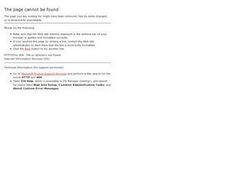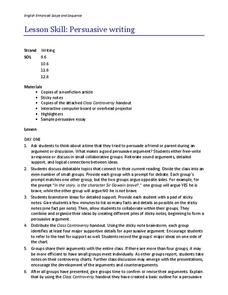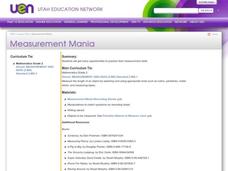Curated OER
A River Ran Wild: An Environmental History
The Nashua River serves as the focal point of an investigation of the treatment of and care for natural resources. A reading of A River Rand Wild: An Environmental History by Lynne Cherry, launches the study and class members consider...
San Francisco Symphony
Biographical Slideshow
Biographies can be a fun topic for any history project. Learners choose one famous person that lived between 1865 and 1930 to research. They gather information, work on reading comprehension, and use what they find to create slide shows...
Curated OER
William Apess and the Mashpee "Revolt" of 1833
Prompt your class with the following question: What was the status of American Indians in Massachusetts during Jackson's presidency? To answer this question, class members will read a series of primary source documents (attached),...
Curated OER
Call It a Hunch
Give young scholars a chance to practice making inferences after reading the book Through My Eyes by Ruby Bridges. They confirm whether or not their conclusions are true, have a class discussion, and then independently complete an...
Curated OER
Narrative Writing vs. Explanatory Writing
The class discusses the different purposes an author has for writing. The focus of the discussion is on writing to tell a true story and writing to give information about a specific topic. There are writing purpose sorting cards embedded...
Virginia Department of Education
Persuasive Writing
Grab a debatable (or controversial) moment from your current reading, and use this task to progress the persuasive writing skills of your high school scholars. Divide your learners into four small groups and let them collaborate, debate,...
Curated OER
Analyzing the Use of Irony in a Short Story
Ninth graders examine how literature connects to real-life and see how irony aids in the development of theme. They read Shirley Jackson's The Lottery, and discuss elements of foreshadowing and situational irony. Then learners will write...
PBS
Heart to Heart
Study heart health and math in one activity. After measuring their resting heart rates by finding the pulse in their wrists, learners build a stethoscope to listen to their heart rate, and note the differences between the two methods.
PBS
Copyright and Fair Use
When is using someone else's copyrighted material appropriate? Learn about copyright and fair use with a lesson from PBS.org. Scholars read through a reference sheet about authors' rights and users' rights, and then create posters for a...
Curated OER
Historical Agency in History Book Sets (HBS)
Study historical events by combining the study of historical fiction and non-fiction. Learners read about true past events in historical fiction novels and then research non-fiction accounts of the same events. What are some differences...
Curated OER
Glossaries
Explore text structure with a focus on the glossary feature in informational texts. Learners read a brief introduction before examining a glossary from a text about plants. They reference it while completing four comprehension questions....
Curated OER
Where Do We Begin?
Primary learners grasp sequence of events by discussing morning routines and reviewing the story of Little Red Riding Hood. They explore the necessity of correct order of events. As a class, create a story with a beginning, middle, and...
Curated OER
My Community Book
Young learners examine different places in their neighborhood using informational texts. First they identify a place that they like to play and predict if it will be in the nonfiction book Community at Play.They will share their favorite...
Curated OER
Writing Process- Expository Writing
Expository writing is the focus of the language arts lesson presented here. In it, young writers review what expository writing is through a class discussion and teacher demonstration. Then, learners write expository text that describes...
Curated OER
Story Scrapbook
Pupils develop a comparison worksheet using one non fiction book and one fiction book they have read to be put into a class scrapbook. In their comparison students must have title, author, point of view, setting, characters, and other...
Curated OER
Lesson Plan on Social Studies Research
Fourth graders listen to nonfiction stories, read fact sheets about historical characters and events, and record facts in groups. They write a paper based on six facts from their research.
Curated OER
Lawton: A Child of the Prairie
Students complete word study activities, read a story and write a descriptive paragraph about the setting of Goo Goo Avenue in Lawton 1901.
Curated OER
The Long and Short of It: Summarizing Important Details
Students practice their summarizing skills while listening to a brief biography of Amelia Earhart. Students take notes while the teacher reads the article and write a paragraph that summarizes the important events from Amelia Earhart's...
Curated OER
Identify and Evaluate Problem-Solving Processes and Solutions
Students identify a problem, the process by which it is solved, and the solution in a piece of literature. In this problem solving lesson, students read a nonfiction passage and use a think-pair-share strategy to identify the problem...
Curated OER
Measurement Mania
Second graders get many opportunities to practice their measurement skills.
Curated OER
Developing Open-Ended Questions
Students work in groups of two to develop questions and sample answers that are relevant, accurate and use higher level of thinking skills about a literary unit. Students present their questions and answers to the class as a review of...
Curated OER
I Am What I Think I Am!
Students study conative and cognitive strengths through characters in literature. In this conative and cognitive strength lesson, students read about a favorite character or historical person. They make a chart of the difficulties the...
Curated OER
Wars and Conflicts
Students explore the concepts of war and conflict. In this research skills lesson, students use Internet and print sources to research the causes, effects, main events, and significant figures of selected wars.
Curated OER
Inventing and Presenting Unit 1: Analyzing Nonfiction and Inventing Solutions
Students read about and identify patterns in the invention process. Students discuss and write about information learned from research. Students compile a list of problems, choose one, write a problem statement, and compile a list of at...

























